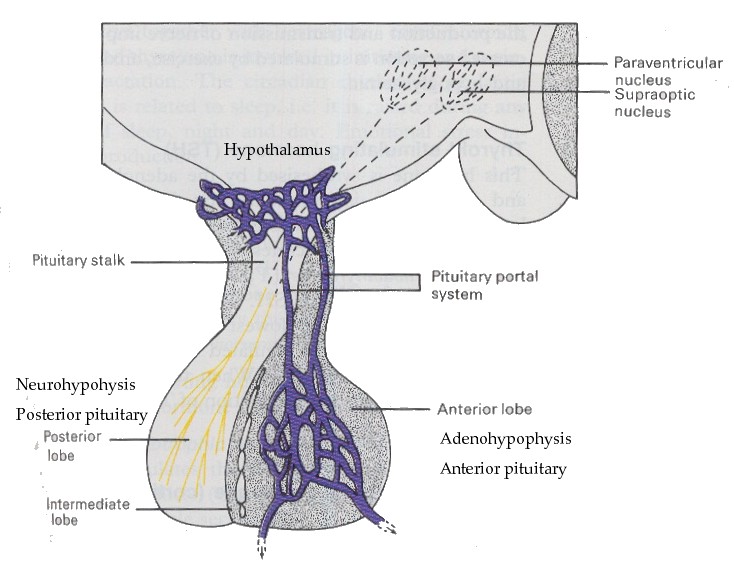Hormones by Posterior Pituitary
Posterior pituitary gland releases 2 hormones
1. Antidiuretic Hormone (ADH), or arginine vasopressin (AVP)
2. Oxytocin
Production of Antidiuretic Hormone
Both the hormones are produced in hypothalamic nuclei
Antidiuretic hormone is produced in SON of hypothalamus
- Supraoptic nucleus → ADH + 1/6 oxytocin
- Paraventricular → Oxytocin + 1/6 ADH
Both hormones are polypeptides containing 9 aminoacids
Transport
Both are transported along the hypothalamo--hypophyseal tract in combination with carrier protein called 'neurophysin', to the nerve enpodings in the posterior pituitary gland where they are stored.
Functions & Control of ADH
ADH increases water reabsorption by the distal tubules & collecting ducts of the kidneys leading to reduction in the osmotic pressure of the blood
Control of ADH release :
dehydration - osmolality of plasma increases - osmoreceptors in the hypothalamus - ADH secretion is increased - water reabsorption in the kidneys is increased to combat dehydration
- When blood volume is decreased the mechanoreceptors in the great arteries (aorta and carotids) and right atrium are stimulated which in turn increases ADH secretion and release
- Decreased blood pressure due to decreased blood volume increases the ADH
- increasing age causes increased ADH
- Pain, emotional stress and physical trauma increase ADH
- Drugs e.g. morphine, barbiturates and nicotine increase ADH
ADH secretion decreases in
Alcohol consumption
Symptoms of deficiency of ADH
Lack of ADH : leads to Diabetes insipidus
Signs and Symptoms
Polyurea - 20 L/day
Polydipsia
Decrease in the specific gravity of urine
Increase in plasma osmolality
Increase in ADH : Schwartz-Bartter Syndrome - occurs after surgery of ademoma of pituitary, ectopic kidney, bronchial carcinoma
Signs and Symptoms
hyponatremia
Mental confusion
Coma
death due to vetnricular fibrillation
Production of Oxytocin
Produced mainly in the paraventricular nucleus of the hypothalamus
Functions and Control of Oxytocin
Action : contraction of the smooth muscles of the uterus - enances labour
Contraction of mammary gland myoepithelial cells of the alveoli and the ducts - ejection of milk as a reflex in lactating women
In men increases ejaculation
Oxytocin is concerned with releasing or ejection of milk, while prolactin is concerned with synthesis and production of milk.
Factors increasing oxytocin release
Stimulation of nipple
visual or auditory stimuli from the baby
Distension of uterus and stretching of cervix during delivery
Coitus
Psychological and emotional factors e.g. fear, anxiety and pain
Factors decreasing oxytocin secretion
Alcohol
Hormones : progesterone - decreases uterine sensitivity to oxytocin
estrogen - increases uterine sensitivityto oxytocin
* * * * * * * * * * * * *



